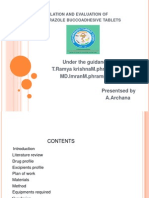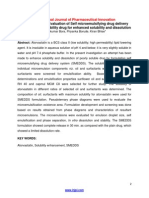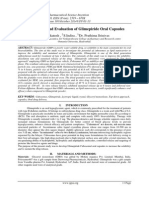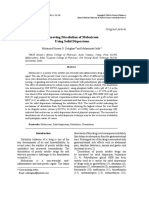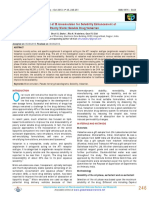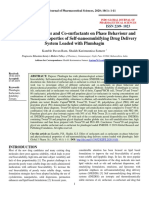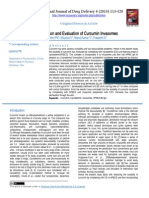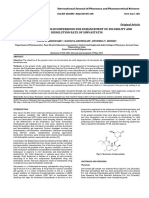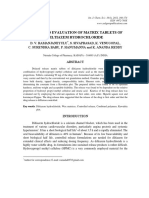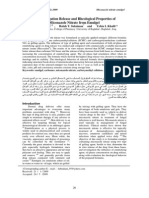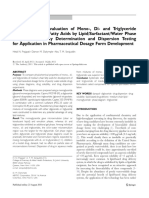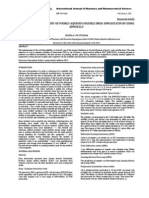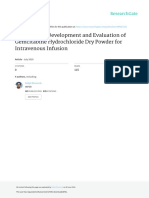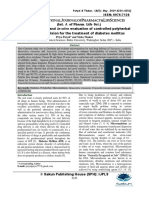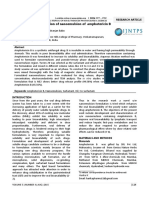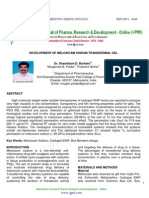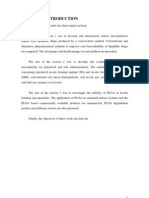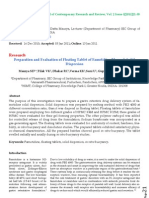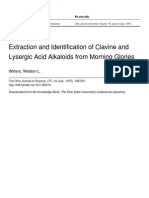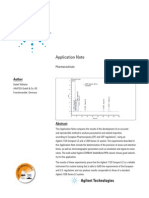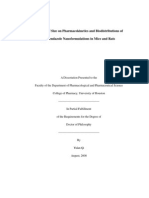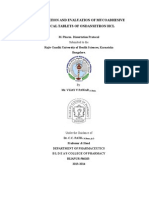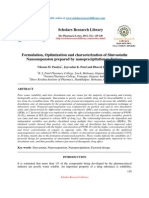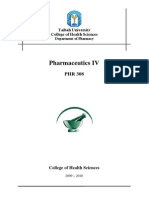1214 Full PDF
1214 Full PDF
Uploaded by
FeslyAnugerahAriestaPayungCopyright:
Available Formats
1214 Full PDF
1214 Full PDF
Uploaded by
FeslyAnugerahAriestaPayungOriginal Title
Copyright
Available Formats
Share this document
Did you find this document useful?
Is this content inappropriate?
Copyright:
Available Formats
1214 Full PDF
1214 Full PDF
Uploaded by
FeslyAnugerahAriestaPayungCopyright:
Available Formats
1214 International Journal of Pharmaceutical Sciences and Nanotechnology Volume 3 Issue 4 January-March 2011
Research Paper
Microemulsion Drug Delivery System: A Platform for
Improving Dissolution Rate of Poorly Water Soluble Drug
Surjyanarayan Mandal* and Snigdha. S. Mandal
Baroda College of Pharmacy, Vadodara, India.
ABSTACT: The aim of the present study was to design novel o/w microemulsion of Glimepiride and to study its
dissolution behavior by raising its solubility. Oil and surfactant were selected based on their drug solubilizing capacity and
HLB value. Pseudoternary phase diagrams were developed at different ratios of Cremophor RH 40 and Transcutol P to
know the microemulsion existing zone. Glimepiride loaded microemulsion using Labrafil M 1944 CS, Cremophor RH 40,
Transcutol P as oil, surfactant and cosurfactant respectively, was prepared and characterized. Accelerated stability study of
the developed microemulsion was carried out for 6 months. Drug solubilization capacity of the microemulsion system was
determined. Solubility of Glimepiride by the O/W microemulsion was increased by 5785 times to that of water
(0.019mg0.002). In-vitro drug diffusion study revealed that after 10 hrs of diffusion, more than 18% of the drug was
diffused from the microemulsion system, as compared to the commercially available tablets. Based on the results it could be
concluded that microemulsion formulation could be used as a possible alternative to traditional oral formulations of
Glimepiride to improve the dissolution rate and hence its bioavailability.
KEY WORDS: Microemulsion (ME); Glimepiride (Gli); Bioavailability; Globule size;
Pseudo ternary Phase Diagram; Class II drugs
INTRODUCTION
The compounds with powerful pharmacological activity
have been screened by remarkable progress of modern
technology, such as structure-based drug design (SBDD),
combinatorial chemistry and high throughput screening
(HTS) in recent years. These compounds often show high
lipophilicity and slight water solubility. In case of the
formulations for oral administration, the lipophilic drugs
(Class II drugs) show the poor gastrointestinal absorption
because of the low solubility or dissolution rate to water
which inturn leads to low and variable oral bioavailability
(Chiou et al., 1976). Therefore, even though such
compounds have powerful pharmacological activity, the
expected clinical efficacy is sometimes not experienced. In
order to increase the clinical efficacy of such lipophilic
compounds at the time of oral administration, many trials
which improve the gastrointestinal absorption and raise
bioavailability have been made. Different technologies
involved for solubility improvement are pulverization,
crystal polymorphism selection, salt formation, solid
dispersion, mixed pulverization, complex formation agent
like cyclodextrin, emulsion, microemulsion and liposome.
The technologies of pulverization and solid dispersion
often produce the aggregation of the compound and it is
difficult for these technologies to maintain
physicochemical stability of the compound (Atkinson RM
et al., 1962). O/W microemulsion is the formulation which
is expected to increase the solubility by dissolving poorly
water soluble compounds into an oil phase, so increase the
dissolution rate and thus to enhance oral bioavailability
and it is also possible for this formulation to raise lymph
directivity and to avoid hepatic first pass metabolism
depending on the kind of oil (Muranishi et al., 1991).
Microemulsion formulation is transparent,
thermodynamically stable and a liquid mixture of oil,
surfactants, cosurfactant and an aqueous phase. Thus, in
this research, we tried to design the novel O/W
microemulsion formulation of Glimepiride which improve
the gastrointestinal absorption by raising its water
solubility and hence oral bioavailability is enhanced.
Glimepiride is one of the third generation
sulphonylurea, antidiabetic drug which stimulates insulin
release. This drug shows low, pH-dependent solubility. In
acidic and neutral aqueous media, Glimepiride exhibits
very poor solubility at 37
0
C (<0.004 mg/ml). In media
pH>7, solubility of drug is slightly increased to 0.02
International Journal of Pharmaceutical Sciences and Nanotechnology
Volume 3 Issue 4 January March 2011
* For correspondence: Surjyanarayan Mandal,
Tel: 02668-262327
E-mail: surjya05n08@gmail.com.
1214
Surjyanarayan Mandal and Snigdha. S. Mandal : Microemulsion Drug Delivery System: A Platform for Improving 1215
mg/ml. This poor solubility may cause poor dissolution
and unpredicted bioavailability (Kiran et al., 2009). Hence
administering Glimepiride by oral route appears as a
formidable challenge due to its poor absorption pattern and
rapid and unpredictable hepatic first pass metabolism. The
extent of absorption and bioavailability enhancement of
lipophilic drugs could be observed particularly by
improving their residence time in the intestinal mucosa and
protecting the drug from the enzymes through intestinal
lymphatic transport of drugs (Shah et al., 1994).
Since in-vitro dissolution rate is the rate limiting step in
drug absorption for class II drugs like Glimepiride and so
as to increase the concentration of dissolved drug at the
absorption site by increasing the dissolution rate, solubility
of Glimepiride was enhanced by microemulsion
formulation. In the present study, a microemulsion
formulation was prepared using Labrafil M 1944 CS,
Cremophor RH 40, Transcutol P and distilled water by
water titration method. Pseudoternary phase diagrams
were constructed to find out the zone of microemulsion at
different ratios of Cremophor RH 40 to Transcutol P (e.g.,
1:1, 2:1, 3:1 and 3.5:1). The effect of formulation variables
on different physicochemical characteristics such as %
transmittance, and droplet size was studied. An in-vitro
diffusion study was performed using rat duodenum to
determine the rate and extent of permeation from prepared
microemulsion, plain drug solution and suspension of
tablet.
Materials and Methods
Materials
Glimepiride was received as a gift sample from Alembic
pharmaceutical Ltd. (Vadodara, India). Labrafac CM10,
Maisine 35-1, Labrafil M 1944 CS and Labrafac PG were
received as gift sample from Gattefosse (Mumbai, India).
Cremophor RH 40 and Cremophor EL were obtained from
Colorcon Asia (Mumbai, India). Span 20, Tween 60,
Tween 80, PEG 600, PEG 400 and Methanol (HPLC
grade) were bought from Gujarat chemical corporations
(Vadodara, India). All other chemicals were reagent grade.
Animals
Animal experiments were approved by Animal ethical
committee, Ministry of Government of India, New Delhi,
India, with the permission number of 404/01/a/CPCSEA.
Male albino rats were obtained from Zydus Health Care,
Ahmadabad, India.
Methods
Solubility Studies: The solubility of Glimepiride in various
components like oils and surfactants was determined. 3 ml
of each of the selected vehicles was added to each cap vial
containing an excess of Glimepiride. After sealing, the
mixture was heated at 40C in a water bath to facilitate the
solubilization. Mixing of the systems was performed using
a vortex mixer. Formed suspensions were then shaken with
a shaker at 25C for 48 hrs. Then each vial was centrifuged
at 3000 rpm for 10min, and excess insoluble Glimepiride
was discarded by filtration using a membrane filter (0.45
m, 13 mm, Whatman, Mumbai, India) (Mehta et al.,
2009). The concentration of Glimepiride was then
quantified by UV-VIS Spectrophotometer at 228nm.
Pseudoternary Phase Diagrams: Pseudoternary phase
diagrams were constructed to examine the formation of oil
in water microemulsions and microemulsion existing zone
using 4 components: oil (Labrafil M 1944 CS), surfactant
(Cremophor RH 40), cosurfactant (Transcutol P), and
aqueous phase system (double-distilled water).
Pseudoternary phase diagrams were constructed keeping
the ratio of Cremophor RH 40 (HLB-15) and Transcutol P
(HLB=4) constant i.e., 1:1, 2:1, 3:1, and 3.5:1 w/w and
varying the remaining 2 components. For convenience, the
phase diagrams were constructed by drawing water
dilution lines representing increasing water content and
decreasing surfactant-cosurfactant levels (Garti et al.,
2000). If turbidity appeared followed by a phase
separation, the samples were considered to be biphasic. If
clear and transparent mixtures were visualized after
stirring, the samples were considered monophasic. The
samples were marked as points in the phase diagram. The
area covered by these points was considered to be the
microemulsion existence region. To determine the effect of
drug on the microemulsion existing zone, phase diagrams
were also constructed in the presence of drug using drug-
enriched oil as the hydrophobic component.
Preparation of Microemulsion: Liquid microemulsions
were prepared by dissolving Glimepiride in Labrafil M
1944 CS. To this, optimized ratio of Cremophor RH 40
and Transcutol P was mixed followed by gentle mixing
with distilled water. The monophasic formulations were
formed spontaneously at room temperature. Dilution study
was also performed with the optimized microemulsion
(Ghosh et al., 2006).
Characterization and Evaluation of
Microemulsion
Refractive Index and Percentage Transmittance: The
refractive index of the system was measured by an Abbe
refractometer (Bausch and Lomb Optical Company,
Rochester, NY) by placing one drop of solution on the
slide. Transparency of microemulsion formulation was
determined by measuring percentage transmittance at 650
nm with purified water taken as blank through U.V.
Spectrophotometer (UV-1601-220X. SHIMADZU) (Date
et al., 2008).
1216 International Journal of Pharmaceutical Sciences and Nanotechnology Volume 3 Issue 4 January-March 2011
Droplet Size Analysis: Droplet size measurement of
optimized ME formulations was carried out by dynamic
light scattering through Zetasizer HAS 3000 (Malvern
Instruments Ltd., Malvern, UK).
Viscosity and Conductivity Measurements: The viscosity
of the optimized ME was evaluated by a Brookfield LVDV
111 +CP viscometer (Stoughton, MA) at 25
0
C using a
CPE 42 spindle at 5 rpm. Experiments were performed in
triplicate for each sample and results were presented as
average standard deviation. Electrical conductivity of
microemulsion was measured using a conductometer (CM
180 conductivity meter, Elico, India) at ambient
temperature. For the conductivity measurements, the tested
microemulsions were prepared with a 0.01N aqueous
solution of sodium chloride instead of distilled water.
Stability Studies: Stability study was performed as per the
procedure given in literature (Araya et al., 2005).
(a) Preservation stability- Glimepiride loaded o/w
microemulsion (formulation-2 mg/mL) was
prepared and stored for 6 months first at
refrigerating condition (2
0
C - 8
0
C) followed by
room temperature and elevated temperature (50
2
0
C) and shelf life of the stored microemulsion
system was evaluated by visual inspection (phase
separation), % transmittance, particle size and %
assay. Samples were obtained on the 2
nd
, 4
th
and 6
th
month and evaluated.
(b) Stability in an acidic solution- Drug entrapped o/w
microemulsion (2 mg/mL, pH=6.4) prepared and
was diluted to four volumes of the solution of pH
1.2 prepared by 5M hydrochloric acid and PBS (pH
6.8) and mixed. Samples were obtained at 4 Hr and
24 Hr after storage at 37
0
C and then %
transmittance, % assay and the particle diameter
were performed.
(c) Stability in artificially bile- Drug entrapped o/w
microemulsion (2 mg/mL) prepared and was diluted
to one volume of artificially prepared and mixed.
Samples were obtained at 4 and 24 after storage at
37
0
C and the measurements of drug concentration,
% transmittance and the particle diameter were
performed.
Determination of Glimepiride Content in the microemulsion:
Glimepiride was estimated from mcroemulsion
formulation by U.V. spectrophotometer at 228 nm.
In-Vitro Release Studies: The methods employed were
modified from experimental procedures well described in
the literature (Aboofazeli et al., 2003). Male albino rats
(230-270 g) were killed by overdose with pentobarbitone
administered by intravenous injection. To check the
intraduodenal permeability, the duodenal part of the small
intestine was isolated and taken for the in vitro diffusion
study. Then this tissue was thoroughly washed with cold
Ringers solution to remove the mucous and lumen
contents. The samples (2 mg/mL) of microemulsion, plain
drug solution and suspension of marketed formulation
(each 500g) were injected into the lumen of the
duodenum using a syringe and the 2 sides of the intestine
were tightly closed. Then the tissue was placed in a
chamber of organ bath with continuous aeration and a
constant temperature of 37
0
C. The receiver compartment
was filled with 100 mL of phosphate-buffered saline (pH
7.4). The absorbance was measured using a UV-VIS
spectrophotometer at a wavelength of 228 nm, keeping the
respective blank. The percent diffusion of drug was
calculated against time and plotted on a graph.
Results and Discussion
Solubility Study: Labrafil M 1944 CS (HLB Value=4)
showed higher solubilizing capacity compared to other
vehicles and hence was selected as oil phase. Cremophore
RH 40 (HLB Value=15) was selected as surfactant due to
its higher drug solubilising capacity, biocompatibility and
Transcutol P were selected as co-surfactant due to its
ability to form clear and stable microemulsion formulation.
The data of selection criteria different components of
Glimepiride loaded microemulsion is given in Table 1.
Table 1 Results of selected components of microemulsion.
Vehicles HLB Value Solubility (mg/ml)
Sunflower oil 7.1 24.94 0.22
Isopropyl Myristate 11.5 34.92 0.81
Soya bean oil, 7.2 20.13 0.53
Labrafil M 1944CS 4.0 41.34 0.83
Capmul CMC 4.6 8.46 0.39
Labrafac CC 1.0 26.54 2.7
Tween 60 15.6 5.56 0.9
Cremophor EL 15.2 11.42 1.2
Cremophor RH 40 15.0 19.45 1.1
Transcutol P 4.2 18.29 0.39
*Mean S.D. (n =3).
Surjyanarayan Mandal and Snigdha. S. Mandal : Microemulsion Drug Delivery System: A Platform for Improving 1217
Solubility of drug was determined in optimized ME and its
individual components. Figure 1 shows the solubility of
drug that optimized ME has higher solubilizing capacity
(115.160.84 mg/ml) than its oil phase (Labrafil M 1944
CS 41.34 mg/ml), surfactant (Cremophore RH
4019.45 mg/ml) taken, individually. So Labrafil M 1944
CS based microemulsion formulation can increase the
solubility of lipophilic drug i.e., Glimepiride.
Pseudo Ternary Phase Diagram Study: A pseudoternary
phase diagram of the investigated quaternary system
Labrafil M 1944 CS/ Cremophore RH 40/ Transcutol P
water is presented in Figure 2. Formation of
microemulsion systems (the shaded area) was observed at
room temperature. Phase behavior investigations of this
system demonstrated the suitable approach to determining
the water phase, oil phase, surfactant concentration, and
cosurfactant concentration with which the transparent,
monophasic low-viscous microemulsion system was
formed. The phase study revealed that the maximum
proportion of oil was incorporated in microemulsion
systems when the surfactant-to-cosurfactant ratio (Km)
was 3:1. Increased oil content in microemulsions may
provide a greater opportunity for the solubilization of
Glimepiride which is an added advantage. Moreover, when
the composition % w/w of surfactant-cosurfactant mixture
in a microemulsion preparation was < 40%, the
formulation was less viscous. The optimum formulation of
microemulsion contained Labrafil M 1944 CS (8%),
Cremophore RH 40 (32%), Transcutol P (8%), and water
(52%).
0
20
40
60
80
100
120
140
Microemulsion Labrafil M 1944 CS Cremophore RH 40 Transcutol P Water
Vehi cl es
S
o
l
u
b
i
l
i
t
y
(
m
g
/
m
l
)
Fig. 1 Solubility data of drug in different vehicles.
Km = 1:1 Km = 2:1
Km = 3:1 Km = 3.5:1
Fig. 2 Pseudotermary Phase diagram at different Km
1218 International Journal of Pharmaceutical Sciences and Nanotechnology Volume 3 Issue 4 January-March 2011
Characterization Results: The physicochemical
characteristics of the developed microemulsion appear in
Table 2. It was clear from the physicochemical data that
the developed system had low viscosity (~27.5 cP). From
the viscosity and electroconductive study it can be
concluded that the system is of o/w type.
The refractive
index of the developed system (1.34) was almost same to
the refractive index of water (1.333). In addition, the
developed systems (10 and 100 times diluted) showed
percent transmittance >99%. The refractive index and
percent transmittance data prove the transparency of the
system. The nanometric size range of the particle was
retained even after 100 times dilution with water, which
proves the systems compatibility with excess water.
Aggregation of the system will not take place due to
charge of the droplets (Cui S et al., 2009). Particle size of
the microemulsion was shown in Figure 3.
Stability Study
Results of the stability study are shown together in Table 3.
No significant difference in the particle size,
%transmittance and % assay of the developed formulation
suggested optimized Labrafil M 1944 CS based
microemulsion was stable up to 3 months.
Table 2 Data of optimized microemulsion
Characterization %Transmittance
Refracti ve
index
Particle
size (nm)
Poly dispersibility
Index (PDI)
% Drug
Content
Glimepiride ME 99.40.3 1.3330.02 23.60.3 0.3210.001 98.720.23
*Mean S.D. (n =3).
Fig. 3 Particle size of the microemulsion.
Table 3 Result of stability study of the microemulsion
% Transmittance Particle Size (nm) % Assay
2
nd
Month 99.60.21 23.60.27 98.120.18
4
th
Month 98.60.19 24.10.51 98.420.33
Preservation stability
6
th
Month 98.80.18 25.30.34 98.190.22
4 Hr 99.40.3 24.30.3 98.650.41 Stability in an acidic solution
24 Hr 98.90.15 24.60.18 98.550.19
4 Hr 99.00.3 23.60.3 98.670.16 Stability in artificial bile
24 Hr 98.10.22 22.90.24 98.270.27
*Mean S.D. (n =3).
Surjyanarayan Mandal and Snigdha. S. Mandal : Microemulsion Drug Delivery System: A Platform for Improving 1219
Fig. 4 In vitro intestinal permeability data.
In Vitro Intestinal Permeability Study: In vitro intestinal
permeability data are shown in Figure 4. The drug diffused
at a faster rate from the microemulsion system than from
the tablet dosage form. The total percentage of drug
diffusion was much higher from the microemulsion system
than that from tablet. After 10 hours of diffusion,
88.27%0.89 of the drug was diffused from the
microemulsion system, as compared with 69.56%1.21
and 51.16%1.53 diffused from the commercially
available tablets and plain drug solution (PDS),
respectively.
Conclusion
The developed microemulsion containing Labrafil M 1944
CS (8%), Cremophore RH 40 (32%), Transcutol P (8%),
and water (52%) was found to be transparent with a
particle size of 23.6 nm and was stable for 6 months.
Solubility of glimepiride by the o/w microemulsion was
increased to 5785 times to water. Results of in-vitro studies
showed significantly higher drug diffusion for developed
Microemulsion formulation compared to suspension of
commercially available tablet. Hence, it can be concluded
that the microemulsion formulation could be employed to
improve the dissolution by solubility enhancement and
hence the bioavailability of a poorly absorbed drug could
be improved. However, further studies in higher animals
and human being need to be performed before this
formulation can be commercially exploited.
Acknowledgements
The authors are thankful to Colorcon (Asia) Pvt Ltd, India
for supplying the oils, surfactants and cosurfactants.
References
Aboofazeli R, Mortazavi SA, and Khoshnevis P. Invitro Release
Study of Sodium Salicylate from Lecithin Based
Phospholipid Microemulsions. Iranian Journal of
Pharmaceutical Research. 5: 95-101 (2003).
Araya H, Tomita M, and Hayashi M. The novel formulation
design of o/w microemulsion for improving the
gastrointestinal absorption of poorly water soluble
compounds. International Journal of Pharmaceutics. 305:
6174 (2005).
Atkinson RM, Bedford C, Child KJ , and Tomich EG. Effect of
particle size on blood griseofulvin-levels in man. Nature.
193: 588589 (1962).
Chiou WL, Chen SJ , and Athanikar N. Enhancement of
dissolution rates of poorly water-soluble drugs by
crystallization in aqueous surface solutions. I. Sulfathiazole,
prednisone, and chloramphenicol. J. Pharm. Sci. 65: 1702
1704 (1976).
Cui S, Nie S, Li L, Wang C, Pan W, and Sun J . Preparation and
Evaluation of Self-Microemulsifying Drug Delivery System
Containing Vinpocetine. Drug Development and Industrial
Pharmacy. 35(5): 603-611 (2009).
Date AA, and Nagarsenker MS.
Design and Evaluation of
Microemulsions for Improved Parenteral Delivery of
Propofol. AAPS PharmSci Tech. 9(1): 138-145 (2008).
Garti N, Aserin A, Tiunova I, and Fanun MA. DSC study of
water behavior in water-in-oil microemulsions stabilized by
sucrose esters and butanol. Colloids. 170: 1-18 (2000).
Ghosh PK, Majithiya RJ , Umrethia ML, and Murthy RSR.
Design and Development of Microemulsion Drug Delivery
System of Acyclovir for Improvement of Oral Bioavailability.
AAPS PharmSci Tech. 7 (3): 1-6 (2006).
Kiran T, Shastri N, Ramakrishna S, Sadanandam M. Surface
solid dispersion of glimepiride for enhancement of
dissolution rate. International journal of pharmtech research.
1(3): 822-831 (2009).
Mehta A, Vasanti S, Tyagi R, and Shukla A. Formulation and
Evaluation of Solid Dispersions of an Anti-diabetic Drug.
Current Trends in Biotechnology and Pharmacy. 3 (1): 76-84
(2009).
Muranishi S. Drug targeting towards the lymphatics. Adv Drug
Res. 21: 1-38 (1991).
Shah N, Carvajal M, Patel C, Infeld M, and Malick A. Self-
emulsifying drug delivery systems (SEDDS) with
polyglycolyzed glycerides for improving in vitro dissolution
and oral absorption of lipophilic drugs. International Journal
of Pharmaceutics. 106: 15-23 (1994).
You might also like
- PPTDocument28 pagesPPTRaj KumarNo ratings yet
- Pharmaceutics: A Practical Manual for PHARM & PHARM D CoursesFrom EverandPharmaceutics: A Practical Manual for PHARM & PHARM D CoursesRating: 5 out of 5 stars5/5 (2)
- Design and Optimization of Chlordiazepoxide Solid Self-Microemulsifying Drug Delivery SystemDocument4 pagesDesign and Optimization of Chlordiazepoxide Solid Self-Microemulsifying Drug Delivery SystemHiteshBariNo ratings yet
- Formulation & Evaluation of SMEDDS of Low Solubility Drug For Enhanced Solubility & DissolutionDocument18 pagesFormulation & Evaluation of SMEDDS of Low Solubility Drug For Enhanced Solubility & DissolutionJohn PaulNo ratings yet
- Formulation and Evaluation of Glimepiride Oral CapsulesDocument13 pagesFormulation and Evaluation of Glimepiride Oral CapsulesinventionjournalsNo ratings yet
- 2 51 1584357062 5ijmpsapr20205Document12 pages2 51 1584357062 5ijmpsapr20205TJPRC PublicationsNo ratings yet
- Formulation and In-Vitro Evaluation of Glibenclamide Dry Emulsion in Vegetarian CapsulesDocument5 pagesFormulation and In-Vitro Evaluation of Glibenclamide Dry Emulsion in Vegetarian CapsulesBaru Chandrasekhar RaoNo ratings yet
- SNI - 06 2385 2006 Minyak - NilamDocument8 pagesSNI - 06 2385 2006 Minyak - NilamEuis Wulan AnggraeniNo ratings yet
- Development of Microemulsion For Solubility Enhancement of Poorly Water Soluble Drug ValsartanDocument6 pagesDevelopment of Microemulsion For Solubility Enhancement of Poorly Water Soluble Drug Valsartandini hanifaNo ratings yet
- 4.kalpana ArticleDocument5 pages4.kalpana ArticleBaru Chandrasekhar RaoNo ratings yet
- Development and Evaluation of Nanoemulsion of RepaglinideDocument8 pagesDevelopment and Evaluation of Nanoemulsion of Repaglinidevikrantkadam12No ratings yet
- Sily MarinDocument8 pagesSily MarinphamuyenthuNo ratings yet
- Jurnal Mikroemulsi PDFDocument8 pagesJurnal Mikroemulsi PDFRiee Naxx RekaccNo ratings yet
- Formulation and Evaluation of Thermosensitive Intranasal in Situ Gel of Sumatriptan Succinate by Using A Blend of PolymersDocument9 pagesFormulation and Evaluation of Thermosensitive Intranasal in Situ Gel of Sumatriptan Succinate by Using A Blend of PolymersabikeshNo ratings yet
- Owais MuzaffarDocument18 pagesOwais Muzaffarowishk2No ratings yet
- Data 1Document7 pagesData 1Citra MalasariNo ratings yet
- JPSR 03110106Document9 pagesJPSR 03110106sunilpdNo ratings yet
- 0337 PDFDocument10 pages0337 PDFelsi mindahaNo ratings yet
- Equilibrio Miglyol - CremphorDocument9 pagesEquilibrio Miglyol - CremphorDiego GuzmánNo ratings yet
- 12Document11 pages12Julia GrantNo ratings yet
- Ece 6Document11 pagesEce 6Ellie satrianiNo ratings yet
- Formulasi Sediaan FarmasiDocument11 pagesFormulasi Sediaan FarmasiKukuh PermadiNo ratings yet
- Experiment KumudDocument8 pagesExperiment KumudSudeep KothariNo ratings yet
- Journal of Drug Delivery and TherapeuticsDocument7 pagesJournal of Drug Delivery and TherapeuticsKunal BhambarNo ratings yet
- 6.0 Brief Resume of The Intended Work Enclosure - I 6.1 Need For The StudyDocument8 pages6.0 Brief Resume of The Intended Work Enclosure - I 6.1 Need For The StudyAndrian SumanNo ratings yet
- Dissolution Enhancement and Formulation of Film CoDocument12 pagesDissolution Enhancement and Formulation of Film CobimaNo ratings yet
- MeloxicamDocument9 pagesMeloxicamDenny Hendra SNo ratings yet
- Preparation and Evaluation of Curcumin Invasomes: International Journal of Drug Delivery 6 (2014) 113-120Document8 pagesPreparation and Evaluation of Curcumin Invasomes: International Journal of Drug Delivery 6 (2014) 113-120nophadonNo ratings yet
- Car BomerDocument8 pagesCar BomerEr RicitosNo ratings yet
- Formulation of Solid Dispersions For EnhDocument7 pagesFormulation of Solid Dispersions For Enhpratikdhotre211No ratings yet
- 11 ArticleDocument10 pages11 ArticleBaru Chandrasekhar RaoNo ratings yet
- Solubility Enhancement of Simvastatin A ReviewDocument10 pagesSolubility Enhancement of Simvastatin A ReviewLien Hong Thi BichNo ratings yet
- Diltizem MicrosphereDocument11 pagesDiltizem MicrospheredoddadineshNo ratings yet
- Design and Evaluation of Matrix Tablets of Diltiazem HydrochlorideDocument9 pagesDesign and Evaluation of Matrix Tablets of Diltiazem HydrochlorideSiva PrasadNo ratings yet
- Miconazole Nitrate From EmulgelDocument6 pagesMiconazole Nitrate From Emulgelasit_m100% (1)
- A Comparative Evaluation of Mono Di Triglycerides of Medium Chain Fatty Acids by Lipid-Surfactant-Water Phase Diagram PDFDocument21 pagesA Comparative Evaluation of Mono Di Triglycerides of Medium Chain Fatty Acids by Lipid-Surfactant-Water Phase Diagram PDFpatchris36No ratings yet
- A A A A C CC C A A A A D D D D Eeee M M M M IIII C CC C S S S S C CC C IIII Eeee N N N N C CC C Eeee S S S SDocument5 pagesA A A A C CC C A A A A D D D D Eeee M M M M IIII C CC C S S S S C CC C IIII Eeee N N N N C CC C Eeee S S S SvouudaosuNo ratings yet
- Chapter 2 Review of LiteratureDocument11 pagesChapter 2 Review of LiteratureSandeepNo ratings yet
- Medicina 55 00210 PDFDocument13 pagesMedicina 55 00210 PDFRizqi AmaliaNo ratings yet
- FormulationDevelopment GemcitabineHCl DryPowder For IntravenousInfusionDocument16 pagesFormulationDevelopment GemcitabineHCl DryPowder For IntravenousInfusionDo Thanh HoanNo ratings yet
- Formulation and in - Vitro Evaluation of Controlled Polyherbal Microemulsion For The Treatment of Diabetes Mellitus PriyaDocument16 pagesFormulation and in - Vitro Evaluation of Controlled Polyherbal Microemulsion For The Treatment of Diabetes Mellitus PriyaNisha ThakurNo ratings yet
- Formulation and Evaluation of Nanoemulsion of Amphotericin BDocument9 pagesFormulation and Evaluation of Nanoemulsion of Amphotericin BIchsant DhyngklexNo ratings yet
- 7.formulation and Evaluation of Lycopene Emulgel PDFDocument15 pages7.formulation and Evaluation of Lycopene Emulgel PDFYuppie RajNo ratings yet
- Emerging Trend of Microemulsion in PDFDocument30 pagesEmerging Trend of Microemulsion in PDFrahmiadelianiNo ratings yet
- PR 15003Document6 pagesPR 15003Satvika AdhiNo ratings yet
- 20.Md Musharraf Ali and V.saikishoreDocument9 pages20.Md Musharraf Ali and V.saikishoreBaru Chandrasekhar RaoNo ratings yet
- Jurnal CarbamazepinDocument9 pagesJurnal CarbamazepinRosamaria Yuni UtamiNo ratings yet
- Formulation and Design of Sustained Release Matrix Tablets of Metformin Hydrochloride - Influence of Hypromellose and Polyacrylate PolymersDocument10 pagesFormulation and Design of Sustained Release Matrix Tablets of Metformin Hydrochloride - Influence of Hypromellose and Polyacrylate PolymersDIKANo ratings yet
- 5.development of Meloxicam Sodium Transdermal GelDocument7 pages5.development of Meloxicam Sodium Transdermal GelDenny Hendra SNo ratings yet
- Chapter 1. IntroductionDocument30 pagesChapter 1. Introductionlweon37No ratings yet
- Formulation Development of Ketoprofen Liposomal Gel (KELOMPOK V) PDFDocument8 pagesFormulation Development of Ketoprofen Liposomal Gel (KELOMPOK V) PDFTreesna OuwpolyNo ratings yet
- Shiv IJCRRDocument10 pagesShiv IJCRRnavodaya9No ratings yet
- Available Online Through: ISSN: 0975-766XDocument8 pagesAvailable Online Through: ISSN: 0975-766XAshish TripathiNo ratings yet
- 01piroxicamemulgel PDFDocument14 pages01piroxicamemulgel PDFNymas PutriNo ratings yet
- 2 51 1588072528 6.ijmpsapr20206Document14 pages2 51 1588072528 6.ijmpsapr20206TJPRC PublicationsNo ratings yet
- A Comprehensive Book on Experimental PharmaceuticsFrom EverandA Comprehensive Book on Experimental PharmaceuticsRating: 5 out of 5 stars5/5 (1)
- A Comprehensive Text Book on Self-emulsifying Drug Delivery SystemsFrom EverandA Comprehensive Text Book on Self-emulsifying Drug Delivery SystemsNo ratings yet
- New Polymers for Encapsulation of Nutraceutical CompoundsFrom EverandNew Polymers for Encapsulation of Nutraceutical CompoundsJorge Carlos Ruiz RuizNo ratings yet
- Jurnal Sediaan Nasal PDFDocument4 pagesJurnal Sediaan Nasal PDFFeslyAnugerahAriestaPayungNo ratings yet
- Jurnal Sediaan Mata PDFDocument15 pagesJurnal Sediaan Mata PDFFeslyAnugerahAriestaPayung100% (1)
- Isb Jurnal Alkaloid PDFDocument5 pagesIsb Jurnal Alkaloid PDFFeslyAnugerahAriestaPayung100% (1)
- PCT HPLC PDFDocument8 pagesPCT HPLC PDFFeslyAnugerahAriestaPayungNo ratings yet
- Research Article: Development and Evaluation of Microemulsions For Transdermal Delivery of InsulinDocument7 pagesResearch Article: Development and Evaluation of Microemulsions For Transdermal Delivery of InsulinFeslyAnugerahAriestaPayungNo ratings yet
- 2008 Qi Yulan PDFDocument287 pages2008 Qi Yulan PDFFeslyAnugerahAriestaPayungNo ratings yet
- Formulation and Evaluation of Mucoadhesive Buccal Tablets of Ondansetron HCLDocument15 pagesFormulation and Evaluation of Mucoadhesive Buccal Tablets of Ondansetron HCLFeslyAnugerahAriestaPayungNo ratings yet
- DPL 2011 3 2 129 140 PDFDocument12 pagesDPL 2011 3 2 129 140 PDFFeslyAnugerahAriestaPayungNo ratings yet
- Suppositories PHR308Document20 pagesSuppositories PHR308FeslyAnugerahAriestaPayungNo ratings yet
